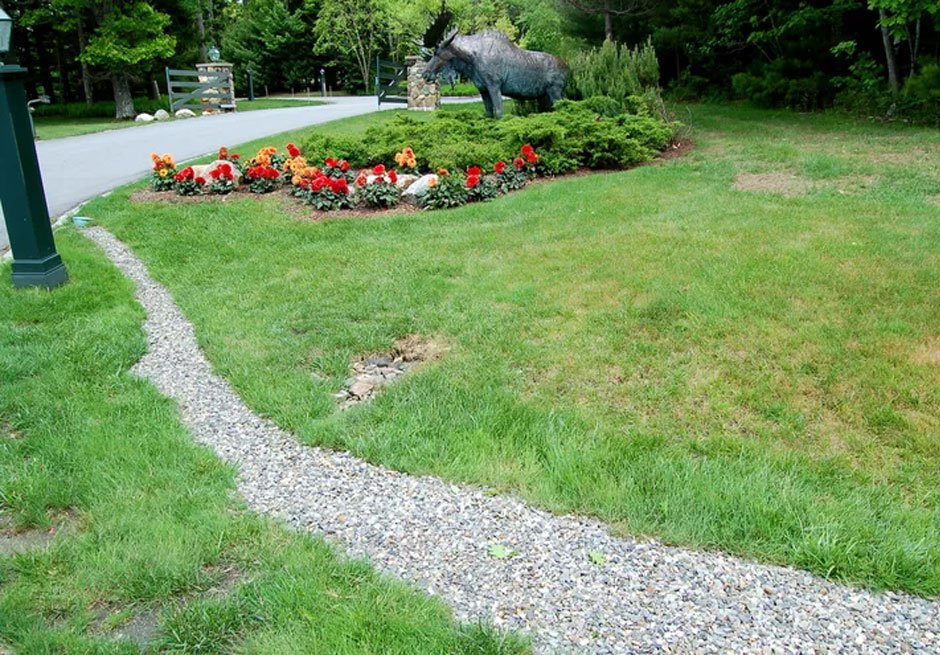Excess surface water in your yard can be a frustrating problem, especially if your neighbor’s land stands at a higher elevation than yours, leading to water runoff after a heavy rain. While you can’t change your neighbor’s land, you can improve your yard drainage with a French drain. In this article, we’ll explore what a French drain is, how to install it, and when to call a professional.
Understanding French Drains
A French drain is a gravel-filled trench lined with landscape fabric to keep soil and silt out of the gravel. While there are different types of French drains, the type used in landscaping deals with excess surface water. The traditional French drain has no drain pipe with gravel running all the way to its surface. With a French drain, surface water flows into the trench, moves freely through the gravel, and exits via a swale, dry well, suitable drainage area, or a rain garden.
Codes and Regulations
Before installing a French drain, check local building codes, zoning laws, or community rules that might impact your yard drainage project. Always confirm your plans with the local building and zoning authority as applicable. It is unlawful to direct water runoff from your property into stormwater systems. If your plan is not approved, you might be able to use an alternative drainage system, such as a dry well, to keep the drainage water on your property and let it soak into the ground rather than flow over the surface.
What You’ll Need
Equipment / Tools
- Hammer
- Mason’s line
- Line level
- Tape measure
- Square spade
- Digging shovel
- Utility knife
- Bow rake
Materials
- Wood stakes
- Landscape fabric
- Landscape fabric staples
- Crushed granite
Instructions
Determine a Trench Location
Assess the flood-prone area(s) of your yard to determine a general location and route for your French drain. Determine where the water should go, and confirm that the drainage end of the trench is in a suitable location. Consider the practical effects of having an exposed gravel channel in the yard and adjust accordingly.
Gain Permission
Confirm that your yard drainage will not adversely impact anyone else’s land or any public areas. Check with your city’s building authority to make sure your plans conform to local law and call 8-1-1 (the national “Call Before You Dig” or “Dig Safe” hotline) to have all underground utility lines marked on your property.
Check the Slope
A French drain must be sloped to carry the water down to its destination. A minimum slope of 1 percent is recommended. Check the natural slope by driving a stake at the beginning and end of the planned trench route. Tie a mason’s line tightly to one stake, run it over to the other stake, attach a line level to the line, and measure straight down from the line to the ground at regular intervals to see how the slope changes. Adjust the depth of the trench as needed to create the desired slope.
Dig the Trench
Cut a straight line through the sod, 3 inches to one side of the line using a square garden spade. Repeat the same process on the other side, also 3 inches from the line, for a total trench width of 6 inches. Remove the sod, then dig the trench, creating vertical sides and a smooth, sloped bottom. Make the trench as deep as desired based on the slope.
Line the Trench With Fabric
Line the trench with landscape fabric, overlapping pieces of fabric by at least 12 inches and securing the ends with fabric staples driven into the ground with a hammer. Fold back excess fabric to both sides of the trench, which can be trimmed to fit later.
Fill the Trench
Fill the trench with coarse drainage gravel, such as crushed granite, so it is flush with the surrounding ground or sod. Rake the top of the gravel, so it is smooth and even with the top of the trench. Alternatively, you can overfill the trench slightly and rake the gravel into a mound so the trench is more visible. Trim excess landscape fabric along the edges of the trench using a utility knife.
When to Call a Professional
Call a professional if excess surface water runs or collects near your house or leads to seasonal flooding inside the house. Likewise, seek expert advice if your planned trench route brings water near (or even closer to) your house or might affect natural runoff patterns. Significant drainage problems may call for regrading and large-scale landscape engineering, which requires specialized expertise and heavy equipment.
Whether you’re installing a French drain to deal with excess surface water or as part of your yard landscaping, following these steps can help you create an effective, inexpensive solution. With the right tools and materials, you can design and install a French drain that works best for your yard.

